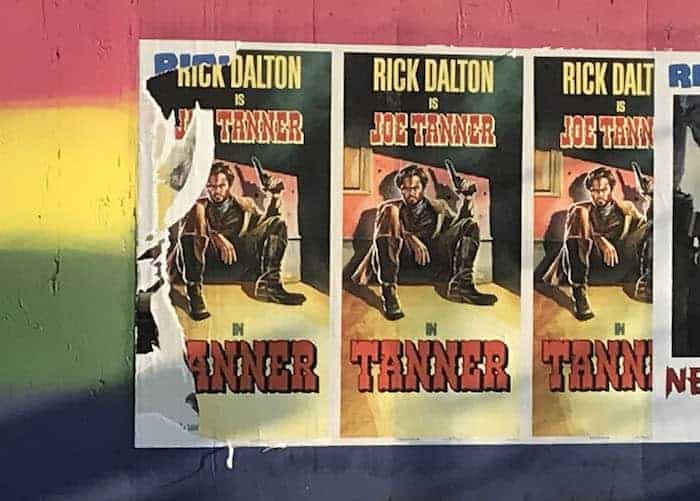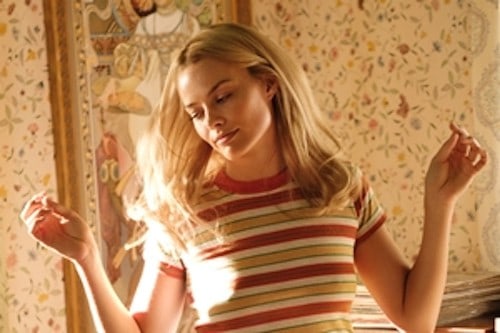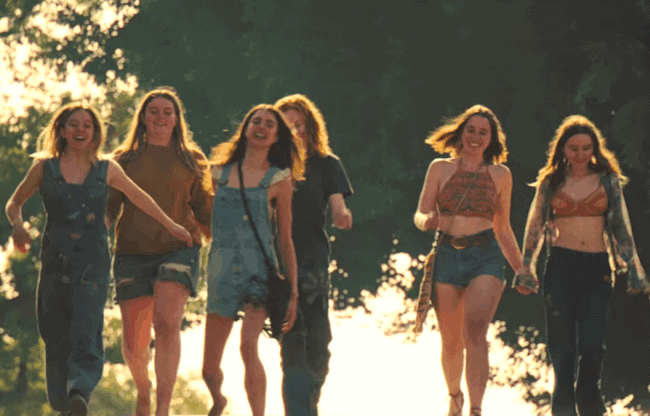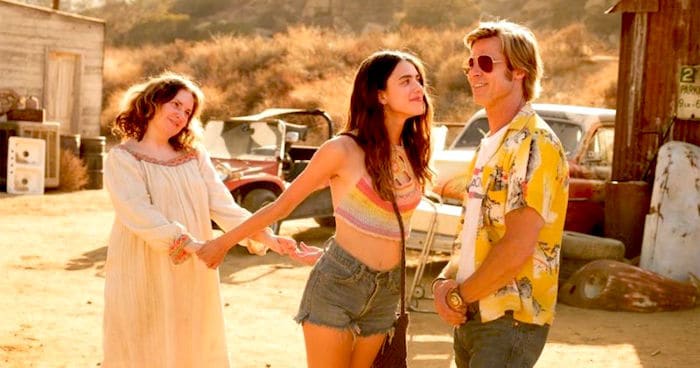The title of Quentin Tarantino’s ninth film is significant. Once Upon a Time . . . in Hollywood. This is how fairytales begin: once upon a time. Something to keep in mind as you watch this juicy look in the rearview mirror at the days when Hollywood films were long on cleavage, polyester, and cowboys with sideburns.

Acid rock competed with the Beatles, Beach Boys and Sly & the Family Stone. Everybody smoked. And marijuana was in its first ascendance. Let me repeat that—everyone smokes in this film. All.The.Time. Which of course was the way it was. Watching the actors smoke amounts to a risk-free contact high.
A lot of things happened in the summer of 1969, and setting foot on the moon was only one of them.
In Hollywood we meet fading TV star Rick Dalton (Leonardo diCaprio) and his faithful stunt double Cliff Booth (Brad Pitt). Dalton, once the star of his own series, is now reduced to picking up work as the bad guy in B grade Westerns and is desperate to keep his career from sinking further into the toilet. He’s lost his license (too many DUIs) and has to be driven by Booth, who is also his best buddy and all-around gofer. They cruise the canyons in Dalton’s 1966 pale yellow Cadillac deVille down the winding roads like a couple of Neal Cassidys, radio blasting, six-pack at the ready.
But things are changing in the movie industry, as the actor, his stuntman, and director Tarantino all mourn. TV is winning, producer’s agendas have become good guy/bad guy deal-making, and it’s no longer the Golden Age of John Wayne and film noir detective thrillers. Dalton needs some serious career counseling, which he gets from a hustler agent Marvin Schwarz, Al Pacino in a delightfully woeful wig. Kid, he’s told, you’re taking guest slots in too many Westernsas the bad guy, the guy who always gets beaten in the gun fight. You keep getting beaten, and people will begin to see you as a loser.
Dalton gets it, and starts examining his life as a potential has-been, while the unflappable Booth tries to keep his boss’ spirits up.
 It’s worth noting that Tarantino’s loveletter to an America gone (and which existed only for some) also grieves for values currently in decline in 21st century America. In a recent op-ed piece Maureen Dowd observed that “
It’s worth noting that Tarantino’s loveletter to an America gone (and which existed only for some) also grieves for values currently in decline in 21st century America. In a recent op-ed piece Maureen Dowd observed that “
You’ll be thinking about that performance, and its implications—and the contrast with the world as it senselessly plays out today—for a long time after the credits finish rolling. (And don’t miss the credits!)
Great details from the get-go. Dalton lives in the big house, a spacious pad with a pool on Cielo Drive up in the hills next to a palatial gated compound rented by Dalton’s idol director Roman Polanski, and his new wife, actress Sharon Valley of the Dolls Tate (Margot Robbie). Already you’re beginning to see where Tarantino might be going with this film, but keep in mind—it’s a fairytale.
 After the end of long days on the set—days in which Dalton is getting fewer parts, and Booth is given fewer stunt gigs—Booth drives Dalton back to Cielo Drive in the Caddie, and then hops into his own battered Karmann Ghia for the long commute back to his airstream trailer in Van Nuys.
After the end of long days on the set—days in which Dalton is getting fewer parts, and Booth is given fewer stunt gigs—Booth drives Dalton back to Cielo Drive in the Caddie, and then hops into his own battered Karmann Ghia for the long commute back to his airstream trailer in Van Nuys.
Tarantino gives Pitt a rare chance to stretch. As Booth he radiates easy confidence, part good-humored ex-Vietnam Vet in tight jeans and part highly-trained martial arts expert whose radar is always humming in the background. This is a man who enjoys life, the downs as well as the ups, and his scenes with his beloved pitbull Brandy, are priceless. Pitt is mesmerizing, and not simply because in one scene, a hot day and he’s up on Dalton’s roof checking the TV antenna, he’s forced to strip off his shirt. I’m thinking of writing Tarantino a “thank you” note for that one shot alone. Not since he debuted way back in Thelma and Louise has Pitt looked this good. Capable of serious danger, he keeps his easy grin. Until he doesn’t.
DeCaprio is just as good, and I’ve never been a fan. Rehearsing his scenes in a new Western, DeCaprio’s Dalton is an explosion of hungover rage, humiliation, irritation, and bad luck. When he blows his lines and needs to take a break, he returns to his trailer on the set and proceeds to throw an epic fit of self-loathing, breaking everything in sight and swearing off liquor just long enough to get the scene right when he goes back for another take. And by the way, when he does, he’s spellbinding.
Most of this movie relies upon the rapport between these two actors. Effortless together, they create an easy rider ambience (DeCaprio’s voice is vintage Jack Nicholson), yet their characters have different goals. Booth just wants to get by. Dalton just wants to maintain a public image.
But of course, Once Upon a Time…in Hollywood, is also about something else that happened in August of 1969.
 So we meet Sharan Tate while her husband is out of the country, and she and her former boyfriend (now constant companion) Jay Sebring (Emile Hirsch) go out to all the parties. Tarantino’s portrait of Tate is as a glowing, all-American beauty enchanted by her own good fortune, good looks, and not much else. She flits, and dances, and skips through Westwood Village, even stopping in a theater to catch a screening of her latest film, squealing with excitement at the sight of herself on the screen. The film’s soundtrack, and settings, plunge us into a made-for-Hollywood fantasy of Hollywood itself. Over-the-top eye candy. Just enjoy it. Meanwhile, Tarantino is an adolescent indulging his own fantasies, of Hollywood, of the 60s and of what might have happened one fateful night.
So we meet Sharan Tate while her husband is out of the country, and she and her former boyfriend (now constant companion) Jay Sebring (Emile Hirsch) go out to all the parties. Tarantino’s portrait of Tate is as a glowing, all-American beauty enchanted by her own good fortune, good looks, and not much else. She flits, and dances, and skips through Westwood Village, even stopping in a theater to catch a screening of her latest film, squealing with excitement at the sight of herself on the screen. The film’s soundtrack, and settings, plunge us into a made-for-Hollywood fantasy of Hollywood itself. Over-the-top eye candy. Just enjoy it. Meanwhile, Tarantino is an adolescent indulging his own fantasies, of Hollywood, of the 60s and of what might have happened one fateful night.
 The scenes of the Spahn Movie Ranch, owned by an old friend of Booth’s, where the Manson Family has decamped feel chillingly authentic. Nothing short of Sergio Leone-meets-David Lynch is the surrealistic atmosphere of Pitt accidentally meeting the Manson family for the first time. When he returns from checking in on old man Spahn he discovers that his car tire has been flattened, and in “persuading” the bad guy to fix the tire he’s damaged, we first see what stunt man Booth is truly capable of. It’s frankly shocking, all the more so since it’s the warm persona of Brad Pitt’s character that suddenly reveals what’s beneath.
The scenes of the Spahn Movie Ranch, owned by an old friend of Booth’s, where the Manson Family has decamped feel chillingly authentic. Nothing short of Sergio Leone-meets-David Lynch is the surrealistic atmosphere of Pitt accidentally meeting the Manson family for the first time. When he returns from checking in on old man Spahn he discovers that his car tire has been flattened, and in “persuading” the bad guy to fix the tire he’s damaged, we first see what stunt man Booth is truly capable of. It’s frankly shocking, all the more so since it’s the warm persona of Brad Pitt’s character that suddenly reveals what’s beneath.
Pitt, and the character he plays, reveal the secret heart of Tarantino’s film, while the astonishing retrofitting of Hollywood Boulevard by set decorator Barbara Ling plunges us into the archetypal neon, eye-popping façade of Tinsel Town. It is the tension as well as the blurring of that buried rage and superficial sunshine that plays so powerfully in this way-too-long film by Tarantino who, as auteur, can do what he damn well pleases.
 The entire film taxes the viewer’s patience as much as it strains even fairytale credulity. But there are scenes to savor that make the experience well worth while (keep in mind Pitt’s abs).
The entire film taxes the viewer’s patience as much as it strains even fairytale credulity. But there are scenes to savor that make the experience well worth while (keep in mind Pitt’s abs).
Back at the Airstream, Cliff Booth opens the first of many cans of beer, then carefully opens two super-sized cans of dog food for his pitbull Brandy. Wonderful timing in Booth’s kitchen ritual as we watch the entire can of glistening brown dog food slurp into Brandy’s chow bowl. Only after Brandy has been told she can eat does Booth sit in front of the TV with his Kraft macaroni and cheese—still in the pan from the stove—and watch an episode of “FBI” on his tiny black and white TV.
And there’s an acting cameo at the Spahn Ranch, which I won’t reveal, also worth the price of admission. And while Robbie is fine as Tate, though not given much more than Breck commercial prancing around to do, it’s the bond between the actor and his double, the boss and the hired hand that makes the film sing. The stunt man actually has lived the life that his buddy, the actor, can only play on the screen
Finally, this is Tarantino, so yes, you can expect to wince during the last half hour of the film. But not for the exact reasons you’re expecting. Pulp Fiction remains the director’s masterpiece, but to watch two fine actors at the top of their game having a great time—as actors and as characters—Once Upon a Time is must-see.
I promised myself I wouldn’t deliver any spoilers, so I have to stop here. There’s tons of semiotic minutiae to dissect. Have fun with it. Especially if you actually remember 1969—this film won’t disappoint.


